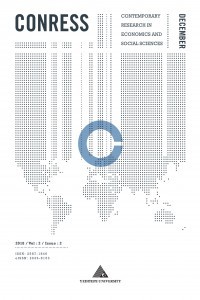The Effects of Female Tertiary Education on Fertility and Development
The Effects of Female Tertiary Education on Fertility and Development
I25 Education and Economic Development, J13 Fertility • Family Planning • Child Care • Children • Youth C23 Panel Data Models • Spatio-temporal Models, C26 Instrumental Variables (IV) Estimation,
___
- References
- Akın, M. Ş., 2005, “Education and Fertility: A Panel Data Analysis for Middle EasternCountries”, The Journal of Developing Areas, Vol. 39, No. 1, pp. 55-69.32Almeida, M. C. C. and Aquino, E. M. L., 2009, “The Role of Education Level in theIntergenerational Pattern of Adolescent Pregnancy in Brazil”, International Perspectiveson Sexual and Reprodcutive Health, Vol. 35, No. 3, pp. 139-146.Bongaarts, J., 2003, “Completing the Fertility Transition in the Developing World: TheRole of Educational Differences and Fertility Preferences”, Population Studies, Vol. 57,No. 3, pp. 321-335.Chen, R. and Morgan, S. P., 1991, “Recent Trends in the Timing of First Births in theUnited States”, Demography, Vol. 28, No. 4, pp. 513-533.Dreze, J. and Murthi, M., 2001, “Fertility, Education, and Development: Evidence fromIndia”, Population and Development Review, Vol. 27, No. 1, pp. 33-63.Geronimus, A. T. and Korenman, S., 1992, “The Socioeconomic Consequences of TeenChildbearing Reconsidered”, The Quarterly Journal of Economics, Vol. 107, No. 4, pp.1187-1214.Gupta, N. and Leite, I., 1999, “Adolescent Fertility Behavior: Trends and Determinants inNortheastern Brazil”, International Family Planning Perspectives, Vol. 25, No. 3, pp. 125-130.Hofferth, S. L., Reid, L., and Mott, F. L., 2001, “The Effects of Early Childbearing onSchooling over Time”, Family Planning Perspectives, Vol. 33, No. 6, pp. 259-267.Kahn, J. R. and Anderson, K. E., 1992, “Intergenerational Patterns of Teenage Fertility”,Demography, Vol. 29, No. 1, pp. 39-57.Klepinger, D. H., Lundberg, S., and Plotnick, R. D., 1995, “Adolescent Fertility and theEducational Attainment of Young Women”, Family Planning Perspectives, Vol. 27, No. 1,pp. 23-28.Manski, C. F., Sandefur, G. D., McLanahan, S., and Powers, D., 1992, “AlternativeEstimates of the Effect of Family Structure During Adolescence on High SchoolGraduation”, Journal of the American Statistical Association, Vol. 87, No. 417, pp. 25-37.Marini, M. M., 1984, “Women’s Educational Attainment and the Timing of Entry intoParenthood”, American Sociological Review, Vol. 49, No. 4, pp. 491-511.McCarthy, J. and Radish, E., 1982, “Education and Childbearing Among Teenagers”,Family Planning Perspectives, Vol. 14, No. 3, pp. 154-155.Moore, K. A. and Waite, L. J., 1977, “Early Childbearing and Educational Attainment”,Family Planning Perspectives, Vol. 9, No. 5, pp. 220-225.Mott, F. L. and Marsiglio, W., 1985, “Early Childbearing and Completion of HighSchool”, Family Planning Perspectives, Vol. 17, No. 5, pp. 234-237.33Olsen, R. J. and Farkas, G., 1988, “Endogenous Covariates in Duration Models and theEffect of Adolescent Childbirth on Schooling”, The Journal of Human Resources”, XXIV,1, pp. 39-53.Ribar, D. C., 1994, “Teenage Fertility and High School Completion”, The Review ofEconomics and Statistics, Vol. 76, No. 3, pp. 413-424.Rindfuss, R. R., John, C. S., and Bumpass, L. L., 1984, “Education and the Timing ofMotherhood: Distentangling Causation”, Journal of Marriage and Family, Vol. 46, No. 4,pp. 981-984.Rindfuss, R. R., 1991, “The Young Adult Years: Diversity, Structural Change, andFertility”, Demography, Vol. 28, No. 4, pp. 493-512.Rindfuss, R. R., Morgan, S. P., and Offutt, K., 1996, “Education and the Changing AgePattern of American Fertility: 1963-1989”, Demography, Vol. 33, No. 3, pp. 277-290.Singh, S., 1998, “Adolescent Childbearing in Developing Countries: A Global Review”,Studies in Family Planning, Vol. 29, No. 2, Adolescent Reproductive Behavior in theDeveloping World, pp. 117-136.Upchurch, D. M. and McCarthy, J., 1989, “Adolescent Childbearing and High SchoolCompletion in the 1980s: Have Things Changed?”, Family Planning Perspectives, Vol. 21,No. 5, pp. 199-202.Upchurch, D. M., Lillard, L. A., and Panis, C. W. A., 2002, “Nonmarital Childbearing:Influences of Education, Marriage, and Fertility”, Demography, Vol. 39, No. 2, pp. 311-329.World Bank, 2013, World Development Indicators.
- Internet Links
- Agüero, J. M., Marks, M., and Raykar, N., 2011, “Do Children Reduce their Mother’sEarnings? Evidence from Developing Countries”, accessed on December 14th, 2015 athttp://www.isid.ac.in/~pu/conference/dec_11_conf/Papers/MindyMarks.pdfBerquo, E. and Cavenaghi, S., 2005, “Increasing Adolescent and Youth Fertility in Brazil:A New Trend or a One-Time Event?”, accessed on December 14th, 2015 athttp://paa2005.princeton.edu/papers/51746Eloundou-Enyegue, P. M., 2004, “Population and Millennium Development: IntegratingTeen Fertility and Gender-Equity Programs”, United Nations Millennium ProjectBackground Paper to the Report “Public Choices, Private Decisions: Sexual andReproductive Health and the Millennium Development Goals”, accessed on December16th, 2015 athttp://www.unmillenniumproject.org/documents/Parfait-final.pdf34Hotz, V. J., McElroy, S. W., and Sanders, S. G., 1999, “Teenage Childbearing and its LifeCycle Consequences: Exploiting a Natural Experiment”, NBER Working Paper Series, No.7397, accessed on December 14th, 2015 athttp://www.nber.org/papers/w7397Klepinger, D., Lundberg, S, and Plotnick, R., 1999, “Teen Childbearing and HumanCapital: Does Timing Matter?”, accessed on December 14th, 2015 athttp://citeseerx.ist.psu.edu/viewdoc/citations;jsessionid=40DFE836E13E7C9AA9E2842C0D4B62D6?doi=10.1.1.199.22Lee, D., 2006, “Reevaluating the Socioeconomic Effects of Teenage Childbearing: ACounterfactual Approach”, accessed on December 14th, 2015 athttp://paa2007.princeton.edu/papers/71702Martin, T. C. and Juarez, F., 1995, “The Impact of Women’s Education on Fertility inLatin America: Searching for Explanations”, International Family Planning Perspectices,Vol. 21, No. 2, accessed on December 14th, 2015 athttps://www.guttmacher.org/pubs/journals/2105295.htmlRafalimanana, H., 2006, “Adolescent Fertility in the Developing World: Levels and Trendsin the 1990s and early 2000s”, paper to be presented at the Annual Metting of thePopulation Association of America, Los Angeles, California, March 30-April 1, 2006,accessed on December 14th, 2015 athttp://paa2006.princeton.edu/papers/60711United Nations Economic and Social Council, 2011, accessed on December 16th, 2015 athttp://www.un.org/press/en/2011/pop994.doc.htm
- ISSN: 2587-1846
- Başlangıç: 2017
- Yayıncı: Yeditepe Üniversitesi
Cemre KALKANDELEN, H. Senem GÖL BEŞER
Atatürk Dönemi Türkiye Ekonomisi ve Osmanlı İmparatorluğu’ndan Devralınan Miras
Mehmet DUDAROĞLU, M.atilla ÖNER, Özgür ÖNDAY
Avrupa Birliği İklim Politikasının Bütünleşmesi’nde Sürdürülebilir Kalkınma’nın Etkisi
The Effects of Female Tertiary Education on Fertility and Development
